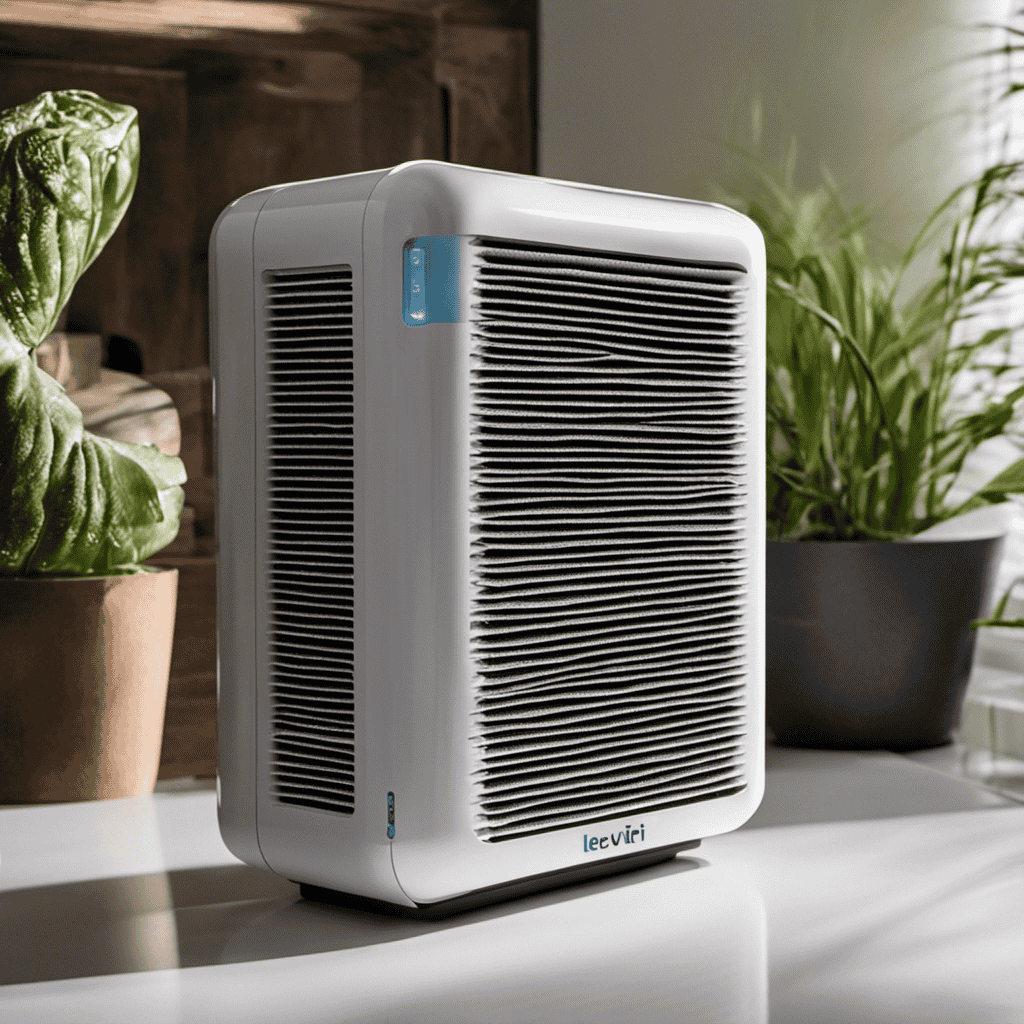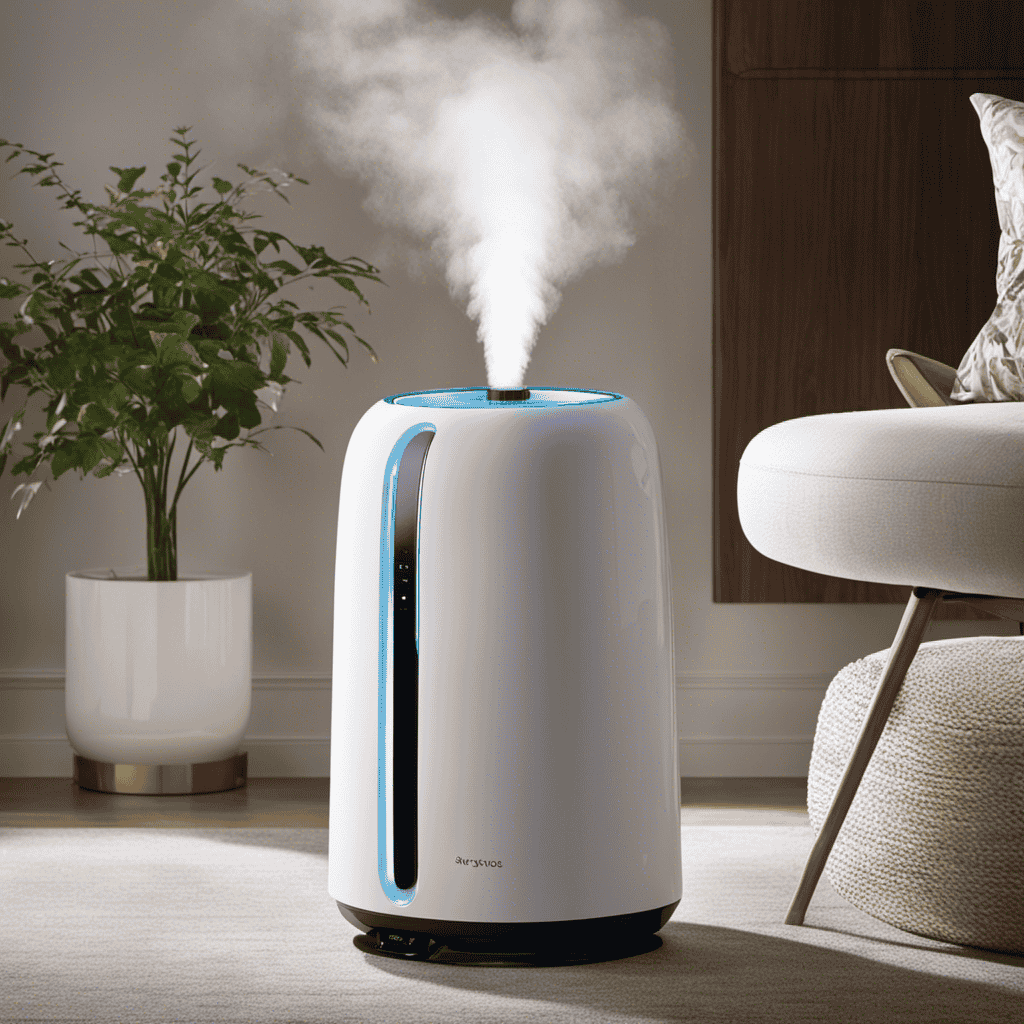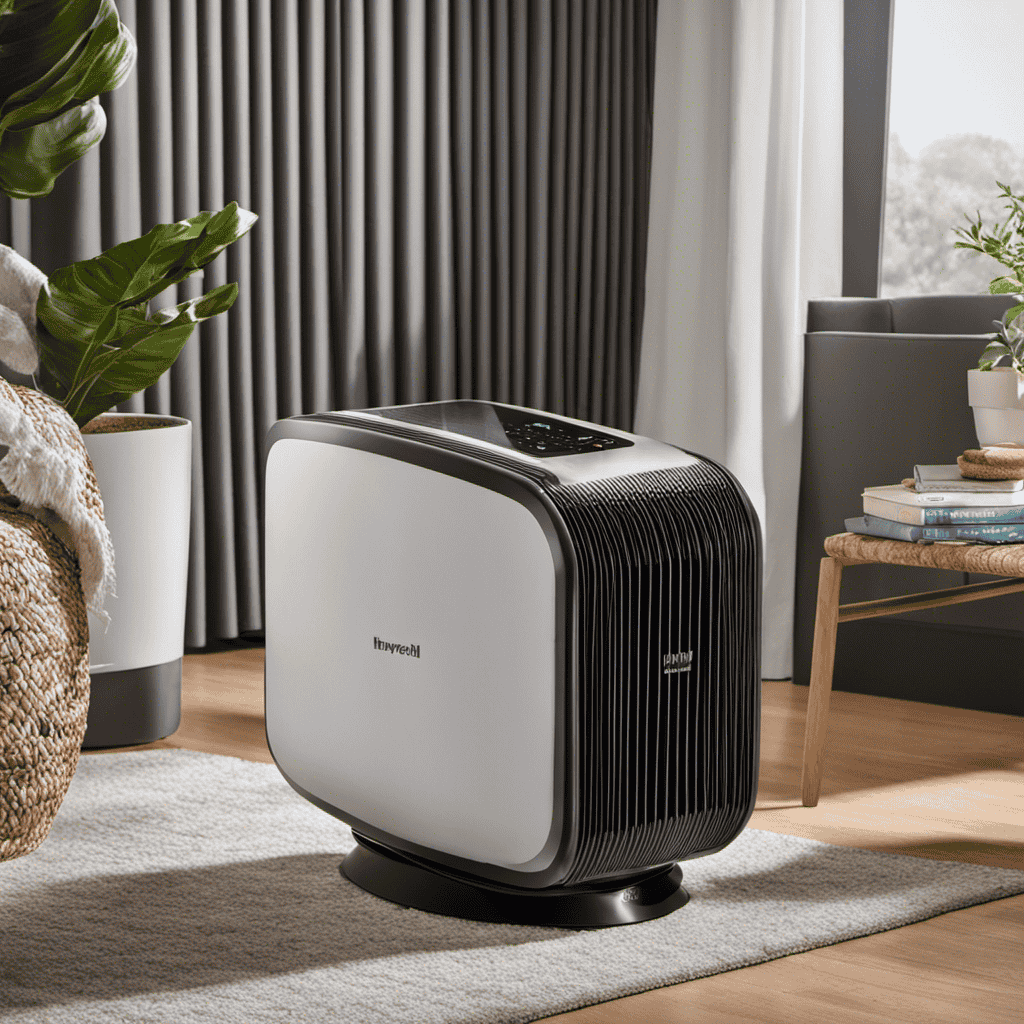I will be providing a useful guide on how to check if your air purifier emits ozone.
Did you know that indoor air pollution can be up to five times worse than outdoor air pollution? That’s why it’s crucial to choose the right air purifier, especially for those with respiratory sensitivities.
In this article, I’ll explain the basics of ozone in air purifiers, how to understand ozone emission levels, and the health risks associated with ozone-producing technologies.
Let’s dive in and ensure the safety of your indoor air quality.
Key Takeaways
- Indoor air pollution can be up to five times worse than outdoor air pollution.
- Ozone is a gas produced by some air purifiers.
- Ozone emission standards set limits on the amount of ozone air purifiers can produce.
- Ozone-free air purifiers are safer alternatives to avoid potential health risks associated with ozone.
The Basics of Ozone in Air Purifiers
Ozone is a gas that is produced by some air purifiers. It is important to understand the basics of ozone in air purifiers, especially with recent ozone regulation updates and the availability of ozone detection devices.
Ozone, also known as O3, is a molecule made up of three oxygen atoms. It is commonly used in air purifiers because of its ability to neutralize odors and kill bacteria and viruses. However, high levels of ozone can be harmful to human health and the environment. That is why regulations have been put in place to limit the amount of ozone produced by air purifiers.
Ozone detection devices can help monitor and measure ozone levels in the air. By understanding the basics of ozone and the importance of monitoring ozone emission levels, we can ensure the safety and effectiveness of our air purifiers.
Understanding the Ozone Emission Levels
To understand the emission levels of your air purifier, you should check the product specifications. The ozone emission standards set limits on the amount of ozone that air purifiers can produce. These standards are designed to protect human health and ensure that ozone levels in the indoor environment remain within safe limits.
Ozone exposure limits have been established based on extensive research and scientific evidence. It is important to note that prolonged exposure to high levels of ozone can have harmful effects on respiratory health.
When evaluating the ozone emission levels of an air purifier, consider the following:
- Look for certifications or compliance with ozone emission standards, such as the California Air Resources Board (CARB) or the Underwriters Laboratories (UL).
- Check the ozone emission rate specified in the product specifications to ensure it falls within the recommended limits.
Differentiating Ozone-Free and Ozone-Producing Air Purifiers
When comparing air purifiers, it’s important to differentiate between models that are ozone-free and those that produce ozone. Ozone, a molecule made up of three oxygen atoms, can be harmful to human health when present in high levels. To ensure the safety of the air we breathe, it is crucial to have effective ozone detection methods in place.
Ozone-free air purifiers use different technologies, such as HEPA filters or activated carbon, to remove pollutants without generating ozone. On the other hand, ozone-producing air purifiers intentionally release ozone into the air to eliminate odors or kill bacteria. However, these models can pose risks to our health.
To avoid the potential dangers associated with ozone, it is advisable to choose ozone-free air purifiers as safe alternatives. Transitioning into the next section, let’s now unmask the hidden dangers of ozone.
Unmasking the Hidden Dangers of Ozone
Did you realize that high levels of ozone in the air can actually be harmful to your health? Ozone, a gas composed of three oxygen atoms, is naturally present in the Earth’s atmosphere. However, human activities such as industrial processes and vehicle emissions can contribute to the formation of excessive ozone levels near the ground.
Uncovering ozone’s effects on human health is crucial in raising awareness about ozone dangers. Here are some key findings:
- Ozone can irritate the respiratory system, causing coughing, chest discomfort, and shortness of breath.
- Prolonged exposure to high ozone levels can worsen respiratory conditions such as asthma and bronchitis.
- Individuals with pre-existing respiratory conditions are particularly susceptible to the harmful effects of ozone.
- Ozone can also trigger inflammation in the airways, leading to long-term damage.
Health Risks Associated With Ozone-Producing Air Purifiers
Using ozone-producing air purifiers can pose health risks due to the potential for increased ozone levels in indoor environments. Ozone, a gas composed of three oxygen atoms, is known to have detrimental effects on human health when present in high concentrations. Prolonged exposure to elevated levels of ozone can lead to respiratory problems, such as coughing, chest pain, and shortness of breath. Additionally, it can exacerbate existing respiratory conditions, such as asthma and chronic obstructive pulmonary disease (COPD). To prevent ozone exposure and minimize the associated health risks, it is important to choose air purifiers that do not produce ozone. To aid in identifying ozone-producing air purifiers, the following table provides a visual representation of key features to look for and avoid:
| Features to Look for | Features to Avoid |
|---|---|
| HEPA filtration system | Ionizers or ozone generators |
| Activated carbon filter | UV-C lamps |
| Electrostatic precipitators | |
| Photocatalytic oxidation |
Ozone Regulations and Safety Standards
When it comes to ozone regulations and safety standards, there are several key points to consider.
First, there are specific limits set on the amount of ozone that can be produced by certain devices or industries. These limits are in place to protect human health and the environment.
Second, there are significant health risks associated with high levels of ozone exposure, including respiratory issues, lung damage, and increased susceptibility to respiratory infections.
Lastly, compliance with these regulations and enforcement of the standards is crucial to ensure that ozone levels are kept within safe limits and that individuals and industries are held accountable for their ozone-producing activities.
Ozone Production Limits
The government has set limits on how much ozone air purifiers can produce. These regulations are in place to ensure the safety and well-being of individuals using air purifiers in their homes or workplaces. Ozone production standards help to control the emissions of ozone, a gas that can be harmful to human health when present in high concentrations.
To meet these ozone production limits, air purifiers undergo rigorous testing and certification processes. Manufacturers must adhere to strict guidelines and ensure that their products do not exceed the allowed ozone emission levels. This is achieved through the use of advanced technologies and filtration systems that effectively remove pollutants from the air without generating excessive ozone.
Health Risks Associated
Now that we have discussed the ozone production limits of air purifiers, let’s delve into the health risks associated with them.
It is crucial to understand that although some air purifiers may produce ozone within the acceptable limits, there are still potential risks involved. Ozone, even at low levels, can irritate the respiratory system and worsen asthma symptoms.
To mitigate these risks, proper air purifier maintenance and filtration are essential. Regularly cleaning and replacing filters ensure that the purifier is effectively capturing and removing pollutants from the air without releasing harmful substances.
Additionally, choosing air purifiers with high-efficiency particulate air (HEPA) filters can further enhance their effectiveness in removing airborne particles, allergens, and pollutants.
Compliance and Enforcement
To ensure compliance and enforcement of ozone production limits, authorities regularly monitor and inspect air purifiers. This helps to ensure that manufacturers and users adhere to regulatory guidelines regarding ozone emissions. Here are some key points to understand about compliance and enforcement:
-
Monitoring and Testing:
-
Authorities conduct regular testing of air purifiers to measure ozone emission levels.
-
They use specialized equipment and standardized testing protocols to ensure accurate and consistent results.
-
Inspection and Auditing:
-
Authorities also conduct inspections of manufacturing facilities and distribution channels to ensure compliance with regulatory guidelines.
-
They review documentation, verify labeling and marketing claims, and check for any violations.
The Importance of Ozone-Free Certification
Ozone-free certification is crucial when determining if an air purifier produces ozone or not. As a consumer, it is important to understand the benefits of ozone-free certification and the importance of independent testing.
Ozone, a harmful gas, can cause respiratory issues and worsen existing conditions such as asthma. By choosing an air purifier with ozone-free certification, you can ensure that the device does not emit this harmful gas into your environment.
Independent testing is crucial in verifying the manufacturer’s claims about ozone-free operation. This testing is conducted by unbiased organizations that evaluate air purifiers based on strict guidelines and standards. By relying on independent testing, you can have confidence in your air purifier’s ability to effectively clean the air without compromising your health.
Testing Methods for Ozone Emissions
You should be aware of the different testing methods used to determine if an air purifier emits ozone. Ozone detection devices are commonly used to measure the ozone levels produced by air purifiers. These devices are designed to accurately detect and quantify the amount of ozone emitted by the purifier.
There are two main testing methods used in this process:
-
Chamber Testing: In this method, the air purifier is placed inside a sealed chamber, and the ozone levels are measured over a certain period of time. This allows for controlled conditions and accurate measurement of ozone emissions.
-
Field Testing: This method involves testing the air purifier in a real-world setting, such as a room or building. Ozone detection devices are used to measure the ozone levels in the air surrounding the purifier. This method provides valuable information on how the purifier performs in everyday conditions.
These testing methods are crucial for ensuring that air purifiers comply with ozone emission regulations and provide users with ozone-free air.
Interpreting Ozone Test Results
After conducting the ozone emission tests on my air purifier, the next step is interpreting the test results and understanding their implications.
To accurately interpret the results, it is crucial to refer to the specific guidelines or standards set by regulatory bodies. These guidelines define the acceptable ozone levels for indoor air quality and provide the basis for evaluating the test results. By comparing the measured ozone levels against these standards, I can determine if my air purifier produces ozone within the safe limits.
Additionally, understanding the implications of the test results involves considering the potential health risks associated with elevated ozone levels. High concentrations of ozone can lead to respiratory issues, such as coughing and chest discomfort. Therefore, if the test results indicate elevated ozone levels, it may be necessary to reconsider using the air purifier or explore alternative options to maintain a healthy indoor environment.
Debunking Common Myths About Ozone in Air Purifiers
Contrary to popular belief, air purifiers can actually produce ozone, which can have negative impacts on indoor air quality. It is important to debunk some common myths surrounding ozone in air purifiers to ensure that we have accurate information about their functioning.
-
Myth 1: Ozone is harmless in small amounts
In reality, even low levels of ozone can cause respiratory issues and worsen conditions such as asthma. -
Myth 2: Ozone is necessary for effective air purification
In truth, many air purifiers can effectively clean the air without generating ozone. Look for models with HEPA filters, activated carbon, or other proven technologies.
Signs of Ozone Production in Air Purifiers
When it comes to determining the presence of ozone in the air, one effective method is to use ozone test kits. These kits provide a quick and easy way to measure the levels of ozone in your environment.
It’s important to be aware of the health effects of ozone, as exposure to high levels can lead to respiratory issues and other adverse health effects.
Ozone Test Kits
To determine if your air purifier produces ozone, you can use ozone test kits. These kits are designed to measure the presence and concentration of ozone in the air. Here are a few key points about ozone test kits:
- Ozone test kits provide a reliable and accurate way to detect ozone emissions from air purifiers.
- They use specialized sensors and reagents to measure ozone levels with high precision.
- Ozone test kits are easy to use, typically involving a simple sampling process and chemical reactions.
- They can detect very low levels of ozone, ensuring accurate results.
- Ozone test kits are essential for ensuring the safety and effectiveness of air purifiers, as high ozone levels can have harmful health effects.
By using ozone test kits, you can confidently determine if your air purifier is producing ozone and take necessary measures to protect your health.
Now, let’s explore the potential health effects of ozone.
Health Effects of Ozone
The potential health effects of ozone can include respiratory issues and worsened asthma symptoms. Ozone exposure risks are a concern due to its ability to irritate and inflame the respiratory system.
Short-term exposure to high levels of ozone can cause throat irritation, coughing, and chest discomfort. Prolonged exposure to ozone can lead to chronic respiratory problems such as bronchitis and reduced lung function.
Long-term health effects of ozone include the development of respiratory diseases, cardiovascular issues, and even premature death in individuals with pre-existing conditions.
It is important to limit exposure to ozone by avoiding outdoor activities during peak ozone hours and ensuring proper ventilation indoors. Regular monitoring of ozone levels and taking necessary precautions can help mitigate the potential risks associated with ozone exposure.
Ozone-Producing Technologies to Watch Out For
You should be cautious of ozone-producing technologies in air purifiers. While air purifiers can be beneficial for improving indoor air quality, some models may emit ozone, which can have harmful effects on human health.
To ensure that your air purifier does not produce ozone, consider the following:
-
Look for ozone detection technology: Some air purifiers are equipped with ozone sensors that can detect and measure the levels of ozone in the air. These sensors provide real-time data and alerts to indicate whether the purifier is producing ozone.
-
Check for ozone free certifications: Many reputable air purifier brands undergo testing to obtain ozone free certifications. These certifications indicate that the purifier has been independently tested and verified to emit minimal or no ozone.
Safe Alternatives to Ozone-Producing Air Purifiers
Consider opting for air purifiers that have been certified as ozone-free to ensure the safety of your indoor air quality.
When it comes to safe alternatives to ozone-producing air purifiers, there are several options available. One such alternative is the use of high-efficiency particulate air (HEPA) filters. These filters are designed to capture particles as small as 0.3 microns, including dust, pollen, pet dander, and mold spores.
Another safe alternative is the use of activated carbon filters, which are effective at removing odors, gases, and volatile organic compounds (VOCs) from the air.
Additionally, electrostatic precipitators can be used as an alternative to ozone-producing air purifiers. These devices use an electrical charge to capture and remove particles from the air.
Overall, by choosing these safe alternatives and implementing ozone reduction techniques, you can improve the quality of your indoor air without compromising your health.
Steps to Reduce Ozone Exposure in Your Home
Opt for ozone-free air purifiers to minimize your exposure to harmful ozone in your home. Ozone is a gas that can have detrimental effects on your respiratory system and overall health.
To ensure you are taking the necessary steps to minimize ozone exposure and maintain good indoor air quality, consider the following:
-
Choose air purifiers with a HEPA filter: High Efficiency Particulate Air (HEPA) filters are designed to trap small particles, such as dust, pollen, and pet dander, without producing ozone.
-
Regularly clean and maintain your air purifier: Dust, dirt, and other contaminants can accumulate in the purifier, reducing its efficiency and potentially leading to ozone production. Clean or replace filters as recommended by the manufacturer.
-
Properly ventilate your home: Open windows and doors to allow fresh air to circulate and dilute any ozone that may be present.
Ensuring Air Purifier Safety for Ozone-Sensitive Individuals
As an individual concerned about air purifier safety, I want to explore the topic of ozone detection methods. By understanding how to detect ozone levels in our environment, we can take proactive measures to minimize our exposure and protect our health.
Additionally, it is important to learn about the potential health risks associated with ozone exposure. This knowledge can help us make informed decisions when selecting air purifiers that are safe and effective for ozone-sensitive individuals.
Furthermore, it is crucial to consider the availability of ozone-free air purifiers. By knowing which options are available, we can ensure that we are choosing a purifier that will not emit ozone and potentially harm our health.
Ozone Detection Methods
You can easily determine if your air purifier produces ozone by using specific detection methods. There are various ozone detection devices and measurement techniques available that can help you assess the ozone levels in your indoor environment.
Here are two commonly used methods:
-
Gas Sensors:
-
Electrochemical Sensors: These sensors detect ozone by measuring the electrical current produced when ozone molecules interact with a sensing electrode.
-
Ultraviolet (UV) Absorption: UV absorption sensors work by measuring the amount of UV light absorbed by ozone in the air. This method is based on the principle that ozone absorbs UV light at specific wavelengths.
-
Chemical Indicators:
-
Potassium Iodide (KI) Solution: This solution changes color when exposed to ozone, allowing you to visually detect its presence.
-
Colorimetric Tubes: These tubes contain a chemical reagent that changes color when exposed to ozone, providing a simple and portable method for ozone detection.
Using these ozone detection devices and measurement techniques, you can accurately determine if your air purifier is producing ozone and take necessary steps to ensure a healthy indoor environment.
Health Risks of Ozone
To understand the health risks of ozone, it’s important to be aware of its potential effects on respiratory function and overall well-being. Ozone exposure can have detrimental effects on the respiratory system, particularly in individuals with pre-existing respiratory conditions such as asthma or chronic obstructive pulmonary disease (COPD).
Inhalation of ozone can cause inflammation and irritation of the airways, leading to coughing, wheezing, and shortness of breath. Prolonged exposure to high levels of ozone can also result in reduced lung function and increased susceptibility to respiratory infections. Additionally, ozone can contribute to the formation of smog, which further exacerbates respiratory issues.
It is crucial to limit ozone exposure and take necessary precautions, such as staying indoors during peak ozone hours and using air purifiers that do not produce ozone, to safeguard respiratory health.
Ozone-Free Air Purifiers
If you’re concerned about the potential health risks of ozone, consider using an air purifier that is ozone-free. Ozone can cause respiratory issues and worsen existing conditions such as asthma.
To ensure that your air purifier is truly ozone-free, look for models that have received ozone free certification. These certifications guarantee that the purifier does not emit any ozone.
Additionally, it is important to consider the ozone emission levels of the air purifier. Look for models that have been tested and have low or no ozone emissions.
Frequently Asked Questions
Can Air Purifiers Produce Ozone?
Air purifiers can produce ozone, but not all do. To determine if your air purifier produces ozone, check the product specifications or labels for information on ozone production. Look for "ozone free" air purifiers to avoid ozone emission.
What Are the Health Risks Associated With Ozone-Producing Air Purifiers?
Long term exposure to ozone-producing air purifiers can have serious health effects. It’s crucial to know if your air purifier produces ozone. Take precautions to protect yourself and your loved ones.
How Can I Determine if My Air Purifier Is Producing Ozone?
I can determine if my air purifier produces ozone by using testing methods for ozone emissions. Common signs and symptoms of ozone exposure include coughing, chest pain, and shortness of breath.
Are There Any Regulations or Safety Standards for Ozone Emissions in Air Purifiers?
There are regulations on ozone emissions and safety standards for air purifiers. These ensure that air purifiers do not produce excessive levels of ozone, which can be harmful to health.
What Are Some Safe Alternatives to Ozone-Producing Air Purifiers?
Safe and effective air purifier options include HEPA filters, activated carbon filters, and ionizers. These alternatives do not produce ozone and can still effectively remove pollutants from the air. Using ozone-free air purifiers has several benefits.
Conclusion
To conclude, it is crucial for individuals to be aware of whether their air purifier produces ozone. Ozone emission levels vary, and understanding this is essential in order to differentiate between ozone-free and ozone-producing air purifiers.
The hidden dangers of ozone should not be ignored, as there are significant health risks associated with ozone-producing air purifiers. It is important to be cautious of ozone-producing technologies and opt for safe alternatives.
By taking steps to reduce ozone exposure, we can ensure air purifier safety, particularly for ozone-sensitive individuals.










